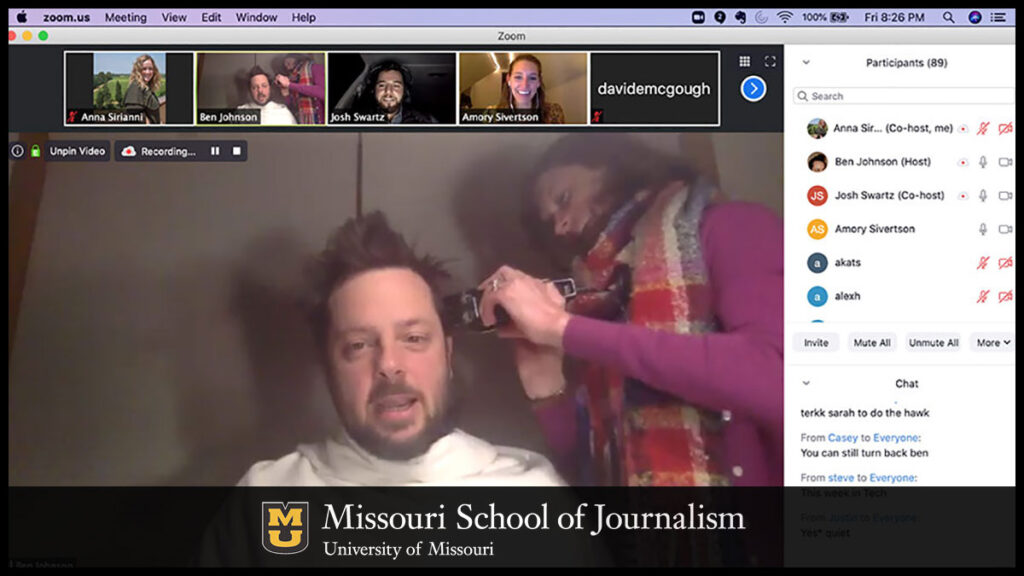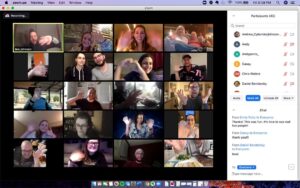Challenge Accepted! How to host a Zoom party for your audience.

Convergence journalism students Grace Huguelet, Anna Sirianni, Chloe Thornberry and Rachel Zalucki worked with podcast producers Endless Thread to help them host a more engaging, interactive Zoom meeting.
Missouri School of Journalism students partner with media organizations to solve problems they face.
By Grace Huguelet, Anna Sirianni, Chloe Thornberry and Rachel Zalucki
Columbia, Mo. (May 11, 2020) — While COVID-19 has made in-person communication difficult, a mostly online world provides an opportunity for media organizations to connect with their audiences like never before.
People are now well versed in accessing video meetings and live streams from home. These technologies can allow journalists to gain a new level of intimacy with their audience.
For example, NPR’s Weekend Edition host Scott Simon started his Open Book video series on Twitter to read poems and literature. The videos provide his followers a chance to relax and listen to the beloved radio personality in a new setting: the book-lined walls of his intimate home office.
Programs with fewer social media followers and smaller audiences can also use this hyper-digital era to connect with their audience. It just takes a bit more marketing muscle.
Adapting to a global pandemic
Endless Thread, a binge-worthy podcast born from a partnership between Reddit and Boston’s NPR Member station WBUR, called upon the four of us at the Missouri School of Journalism to plan a promotional live events tour. When COVID-19 shut down campuses, theaters and life as we knew it, we had to find a different approach to break down the wall between listener and host.
Unlike NPR’s Scott Simon, Endless Thread’s hosts can’t just start livestreams on their personal social accounts and expect hundreds of viewers to tune in.
We needed a way to gather fans in one place without being in the same room. Zoom allowed us to do just that. We devised a Zoom party model, tested prototypes and learned that it’s a replicable, viable way for content creators to meet their audience.
Endless Thread’s audience is small but mighty. The fanbase is almost cult-like; they’re loyal and devoted. They share inside jokes and interact online. This is made possible not only by the nature of the podcast’s Reddit-based content, but also by the rapport of hosts Ben Brock Johnson and Amory Sivertson and producer Josh Swartz. After only one episode, you feel like they’re your long-time friends.
Zoom parties allowed Endless Thread listeners to interact with the podcast team in real time. And the best part – you can do it, too.
Hosting your own Zoom party
It’s crucial to determine why you want to host an online party. Do you want to grow your audience and reach new people or connect with your existing audience? Do you want to teach party attendees about your product or just have fun? Consider these concepts while you plan your virtual event.

Audience
Three months ago, few people knew what Zoom was. Video chatting was reserved for occasionally catching up with long-distance friends or remote coworkers. But now, it’s a daily habit to maintain connections with family members, coworkers, classmates, loved ones and even neighbors. Many of your audience members have likely used it.
Based on your subscription, Zoom can host up to 1,000 participants. If you purchase a large-meeting add-on, make sure to assign it to your account before the meeting starts. If you don’t activate it after purchase, you’ll be capped at 100 attendees.
Tailor your content
Make your Zoom party your own. Plan segments that make sense for your audience. Try to mimic the tone of your content. For Endless Thread, this included trivia, Q&As and even a live haircut.
When your audience is small but mighty like Endless Thread’s, you can expect people to hang on for a several hours-long online event. But this won’t necessarily attract new audience members. Keep your audience in mind when planning your party.
Promoting the event
Both personal and business social media accounts are a useful platform for marketing the event. This will allow you to reach your community of followers as well as anyone else that they share the post with. You can also make a Facebook event so fans can invite their friends and plan ahead.
Endless Thread specifically built an RSVP list – and excitement – for its Zoom party on several channels. A few days ahead of the party, they mentioned the event at the end of a podcast episode, dropped a promotion in the podcast stream and posted on social media.
Tips for getting started
Once you determine your audience and mission, you can decide what type of features to employ. We’ll use Zoom’s language here, since it’s been a popular program lately. Other video conferencing programs include GoToMeeting and Google Hangouts.
- Enable the waiting room feature to allow attendees to hop on before the party starts. This way, attendees won’t be turned away if you’re not ready to start the event. You can manually allow everyone in once you’re ready to get started.
- It may sound obvious, but your Internet connection strength could make or break the event. Make sure you have a reliable Internet connection, a quiet space and a power connection for your device.
- Make sure all co-hosts are on the same page. Small disagreements about when to start the next activity or how long to spend answering questions are awkward to watch. Use a Google Doc to communicate with co-hosts during the event; using iMessage or Slack could lead to audible notifications during the party.
- The first minutes fly by, but they’re crucial. Make your computer setup bulletproof beforehand, not during. Test everything. Even the most loyal, adoring audience doesn’t want to watch you troubleshoot.
- Provide attendees with an agenda. Tell them when the party will end and stick to the schedule. Be considerate of audience members who may be in other time zones.
- If you want to run a Q&A, use a tool like Slido to gather questions in one place. Using the Zoom chat for a Q&A would be too hectic because questions can get lost in the shuffle.
The major takeaway? The pandemic has canceled countless plans, but the media industry is uniquely positioned to reach new audiences. Audience engagement doesn’t have to be put on hold until we can plan in-person events again. In fact, there are new opportunities to connect with audiences as more people learn to use technologies like Zoom.
Grace Huguelet, Anna Sirianni, Chloe Thornberry and Rachel Zalucki are convergence journalism students:
- Huguelet has a bachelor’s with an emphasis in multimedia production and a minor in French and is earning her master’s degree in strategic communication. She has worked at Global Journalist, the Better Government Association, and OVC Lawyer Marketing, and studied abroad in Reims, France. See her previous work at https://gracehuguelet.wixsite.com/portfolio.
- Sirianni has an emphasis in investigative journalism and minors in peace studies and sociology. She has worked at NPR, Kaiser Health News, KBIA and WITF, and studied in Washington, DC while interning at NPR’s headquarters. Follow her on Twitter at @annasirianni.
- Thornberry has an emphasis in emerging media and a minor in psychology. She has worked at Vox Magazine and the Columbia Missourian. She also studied abroad in London, England while interning at Healthista, a health and fitness magazine. Follow her on Twitter at @cthornberryy.
- Zalucki has an emphasis in investigative journalism and minors in Spanish and political science. She has previously worked at KOMU, the Missourian and with ProPublica’s Ground Truth Project covering rural voting patterns in Missouri. In the summer, she will begin her internship with the Honolulu Civil Beat. Follow her on Twitter at @rachelzalucki.
If your news organization could benefit from having a group of talented students work on a new product, service or other innovation, contact RJI Executive Director Randy Picht to explore the options.
Updated: November 12, 2020